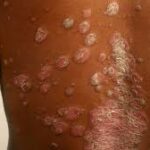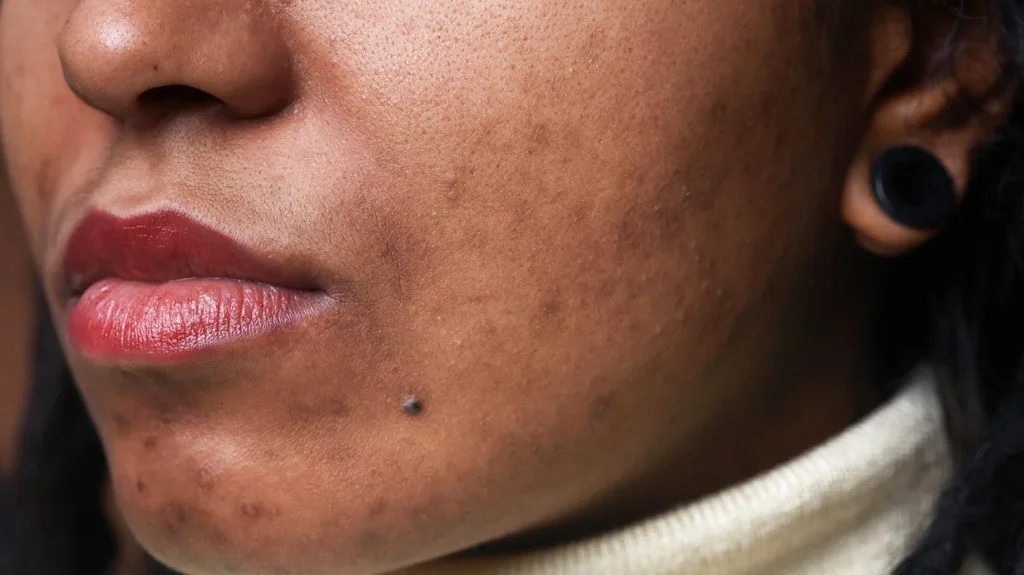
Understanding Your Skin: Keratosis Pilaris
September 16, 2024
Understanding Your Skin: Psoriasis (On Dark Skin)
September 30, 2024From the name you already have an idea about what we’ll be talking about today; post-inflammatory hyperpigmentation. We’ve previously spoken about hyperpigmentation, so if you want to get general knowledge about today’s topic, go read the articles on hyperpigmentation and uneven skin tone. Done with them? Now let’s talk specifically about post-inflammatory hyperpigmentation, what causes it, how it affects people with dark skin tone and how to care for it. Let’s get into it.
What Is Post-Inflammatory Hyperpigmentation?
Generally, hyperpigmentation is a skin issue that arises when an area of skin becomes darker than the skin that surrounds it. It can be caused by many factors, most of which we have previously discussed in this article. Typically, hyperpigmentation can affect many skin tones but it’s often more intense and can last longer on dark skin.
Post-inflammatory hyperpigmentation (or PIH for short) is a type of hyperpigmentation of the skin that is mainly triggered by the way the skin heals and regenerates after an inflammation or injury. It can affect the face and body, typically especially in UV-exposed areas, and appears as flat spots of hypercolouration. These range in colour from pink to red, brown or black, depending on skin tone and the depth of hypercolouration.

What Does Post-Inflammatory Hyperpigmentation Look Like On Dark Skin?
Post-inflammatory hyperpigmentation looks different on different skin tones but for this article, we’ll be talking about how it looks on dark skin. People with post-inflammatory hyperpigmentation will appear to have a mark, spot, or area that’s noticeably darker than their surrounding skin. The exact colour of a hyperpigmented spot can depend on the type and severity of the inflammation that caused it to occur, as well as on your skin tone. But generally speaking, post-inflammatory hyperpigmentation on dark skin appears brown, dark brown, tan, purple, black, greyish-brown, or blueish-grey.
Causes Of Post-Inflammatory Hyperpigmentation (PIH)
The root cause of post-inflammatory hyperpigmentation is increased melanin production. Melanin is the pigment that defines the colour of a person’s skin and the increase in melanin is triggered by how the skin regenerates after an inflammation or injury. The more inflammation there is, the more prominent the discolouration area will be in terms of size and colour.
So, having an injury or an inflammatory skin condition can lead to post-inflammatory hyperpigmentation, especially in people with dark skin tones. For example, you may notice that darker spots appear on your skin after your acne heals. This is called post-inflammatory hyperpigmentation and it has many potential causes, including acne, pseudofolliculitis barbae, eczema, contact dermatitis, psoriasis, lichen planus, lupus, infections that cause rashes, blisters, or sores, insect bites, cuts, burns, and some cosmetic procedures.
While it is not the cause of PIH, sun exposure can aggravate its symptoms by darkening the affected patches and prolonging the time it can take for them to fade. This is why we recommend sun protection. Limit the time you spend in the sun and keep out of the sun during its most intense hours. Wear protective clothing and sun hats whenever possible and apply a sun protection factor of at least 30. Most acne-related post-inflammatory hyperpigmentation will typically fade over time, but it can take several years or even a decade until it completely disappears.

Who Can Develop Post-Inflammatory Hyperpigmentation (PIH)?
Men and women are equally susceptible, and all skin types can get post-inflammatory hyperpigmentation although it is more prevalent in people with darker skin tones. That said, this skin condition is most common in people with:
- Dry skin,
- Eczema,
- Ichthyosis, and
- Melasma.
What Are The Symptoms Of Post-Inflammatory Hyperpigmentation (PIH)?
The most notable symptom of keratosis pilaris is the bumpy appearance of the skin. The visible bumps appearing on the skin resemble goosebumps or the skin of a plucked chicken. For this reason, it’s commonly known as “chicken skin”.
The bumps can appear anywhere on the skin where hair follicles exist and, therefore, will never appear on the soles of your feet or palms of your hands. Keratosis pilaris is common on the upper arms and thighs. It can extend to the forearms and lower legs.
How To Prevent Post-Inflammatory Hyperpigmentation (PIH)
The number 1 tip for preventing post-inflammatory hyperpigmentation is to avoid having any injuries, scars and other skin inflammations like acne. You can also follow the tips below to help prevent post-inflammatory hyperpigmentation:
- Use sun protection: UV rays can cause damage to skin of all colours, potentially affecting pigmentation. If you’re going to be out in the sun, plan to wear sunscreen, stay in the shade, and wear protective clothing.
- Avoid irritants & inflammations: Aim to avoid using any cosmetic or personal care products that cause skin irritation or inflammation.
- Seek professional treatment for skin conditions: Treating inflammatory skin conditions like acne and eczema can help prevent new dark spots from forming.
- Take all medications as directed: Some health conditions, like psoriasis or lupus, can lead to areas of hyperpigmentation, so always be sure to take all medications for these conditions exactly as directed.

How To Treat Post-Inflammatory Hyperpigmentation (PIH)
The key treatment for post-inflammatory hyperpigmentation is treating the underlying condition that caused it in the first place. For example, if it was caused by acne flare-ups brought on by skin sensitivity or a broken skin barrier, treating the skin’s barrier is going to be the first course of action because treating the skin barrier will stop the cycle of acne flare-ups, invariably ending the cycle of post-inflammatory hyperpigmentation.
Consult your dermatologist to work with you to diagnose and set up a treatment plan that’s appropriate for your specific condition. You must stick to this plan to prevent the occurrence of more hyperpigmented spots.
Other treatments include:
- Applying sunscreen of SPF 30 and above. This is because the skin cells produce additional melanin to better absorb harmful UV rays. This means that exposure to sunlight can make dark spots even darker.
- Apply chemical peels topically. They work by gradually removing cells in the epidermis that contain excess melanin. Some examples of chemical peels include glycolic acid and salicylic acid.
- Use Laser treatment of a specific wavelength is directed at areas of hyperpigmentation. The energy from the laser works to destroy cells that contain pigment, lightening the skin.
Generally, PIHs gradually fade in about 6 to 12 months but some can take longer or require more intensive treatment which may be too much for some people. For example, hyperpigmentation that impacts the dermis may take years to fade and, in some cases, can be permanent. So, it’s important to be patient and stick to your treatment plan.

